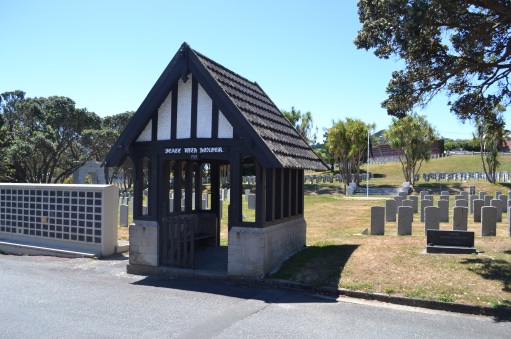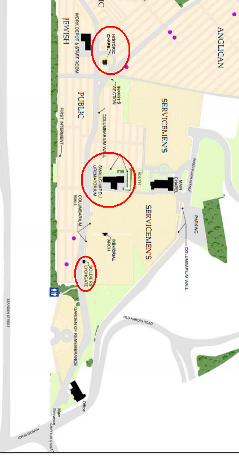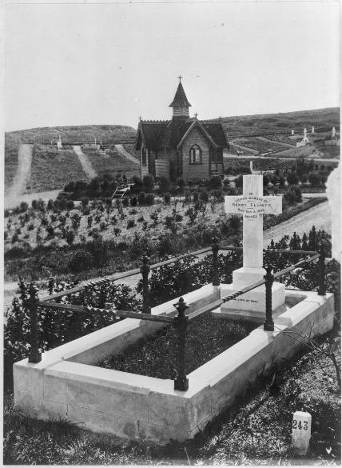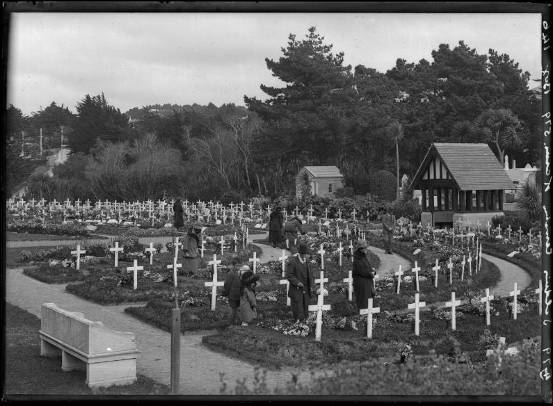Karori Cemetery Mortuary Chapel (Jewish Chapel) 1891; Crematorium & Chapel (1909); Cemetery Lychgate (1921)
Jewish Chapel – aka the Mortuary Chapel Crematorium and Chapel – aka Small Chapel/Crematorium

Jewish Chapel (Mortuary Chapel) 1896. (Image: WCC - Charles Collins, 2015)

Chapel and Crematorium (Image: WCC - Charles Collins, 2015)

Lychgate (Image: WCC - Charles Collins, 2015)


National Library reference: Grave of Henry Elliott, and chapel, Karori Cemetery, Wellington. Ref: 1/2-002383-F. Alexander Turnbull Library, Wellington, New Zealand. http://natlib.govt.nz/records/23082249

Lychgate in c.1925
National Library reference: Soldiers' graveyard, Karori Cemetery, Wellington. New Zealand Free Lance : Photographic prints and negatives. Ref: 1/2-045825-G. Alexander Turnbull Library, Wellington, New Zealand. http://natlib.govt.nz/records/22392835
-
Constructed
unknown
-
-
-
Builder(s)
-
Jewish Chapel (Mortuary Chapel) (1896) is an attractive timber Gothic Revival style building that is notable for its unusual plan shape and form, and the neat detailing of its openings and gables.
Crematorium and Chapel (1909) is a pleasant early 20th century chapel built on a domestic scale. It is notable for the quality of its building materials, its patina of age, and for the fine set of stained glass windows from the An Tur Gloine Studio.
Cemetery Lychgate (1921) is a good representative example of an Arts and Crafts/revivalist-style half-timbered waharoa or gateway.
These three small buildings have considerable group value as a set of early buildings associated with the symbolic, commemorative, traditional, spiritual ceremonies of interment at Karori Cemetery.
The group of buildings are part the wider setting of Karori Cemetery, a site that is undoubtedly one of the most significant historic places in Wellington.The crematorium is one of the first such buildings to have been built in the Southern Hemisphere.
-
Downloadable(s)
-
close
History
-
Wellington city’s first two cemeteries, Bolton Street and Mount Street (Catholic), were both established within a short distance of the centre of Wellington in 1842, and by the 1880s both cemeteries were hopelessly overcrowded. With proximity to central Wellington, and overcrowding, came fears of disease; particularly as both cemeteries were built on land that sloped down to the town, and drainage was poor. Sanitation was an electoral issue as early as the 1850s, and became more prominent as the century progressed. In 1882 the government passed the Cemeteries Act to address issues of public health. The Act prevented the establishment of a new cemetery within the boundary of an existing city or borough. A new multi-faith cemetery opened in Karori in 1891, just ahead of the creation of the Karori Borough later that year.
The first burial at Karori was a month old infant who died on 3 August 1891 and it was another six months before the next burial. The cemetery was divided into zones by religious faith and denomination, in much the same way as Bolton Street, but with the addition of an area for Catholic burials. The various religious burial grounds were consecrated and regular burials began in February 1892. The Bolton Street Cemetery remained an option for interment for those with existing family plots until the late 1960s. The development of the Karori Cemetery was initially slow and most early sites can be found in close proximity to the main entrance.
As the population of Wellington increased so did the demand for both land for housing and for burial sites. Adjoining farmland was purchased as an extension to the burial ground at Karori but soon the, once rural, cemetery was surrounded by suburban housing. By the 1940s the council purchased farmland at Makara, and Makara Cemetery opened for its first burial on the 23rd March 1965. It soon became Wellington’s principal cemetery with interment at Karori limited to those with pre-purchased ash or family plots.
Karori Cemetery is undoubtedly one of the most significant historic places in Wellington. It is the location of nearly 80,000 graves, and of thousands of cremation repositories, and is the second largest burial ground in New Zealand. The cemetery is also remarkable for the scope and accuracy of the historic information it contains. Through its written records and grave inscriptions the cemetery offers social commentary on types of mortality e.g. infant and early deaths, accidents and epidemics. The types of monuments reveal much about taste, affluence (or otherwise) and the impact of a death on grieving relatives.
The graves and resting places of some of the most important New Zealanders of the 19th and 20th centuries, as well as the ordinary citizens of Wellington, are contained within the cemetery’s boundaries. Two of the most notable monuments are the memorial to the victims of the Tangiwai disaster of 1953, and the memorial to 20th century Prime Minister, Peter Fraser. The cemetery is also the resting place for many politicians, church and community leaders, prominent sportsmen and women, explorers, business leaders, civil servants and soldiers. The role that the Services Cemetery plays at Karori is one of its special features. But cemeteries are, to an extent, egalitarian places, in that the distinguished lie alongside thousands of people who never achieved any prominence in society but who lived lives of meaning and fulfilment.
The last 50 years have seen a change in use of the cemetery. Emphasis of management has shifted to conservation and to the future use of the area as a static cemetery without burials. Beautification has become a higher priority, and the community takes an active interest in cemetery’s appearance and its suitability for recreational use.
Jewish Chapel (Mortuary Chapel)
The former Mortuary Chapel is difficult to date. The original open shelter, that was built in c.1891 – 92, was described as a ‘tower with louvres’. Its state of disrepair, its lack of weather-tightness and its dual use for storage were the subject of early complaints. It was enclosed with a door and windows in 1892. A photograph and watercolour painting from 1895 - 96, both of which show the completed chapel, appear to corroborate these dates. The completion date is somewhat complicated by calls from the architect, F. de J. Clere, in 1896 for the Anglican Diocesan Board to build a mortuary chapel, and by claims by the Karori Historical Society that the chapel was built in 1902.
The chapel was the original centrepiece of the cemetery. A number of paths radiated out from the chapel like the spokes of a wheel. As the burial ground grew specific precincts developed, reflecting the city’s increasing ethnic diversity. The Chinese section lay to the southeast while the Jewish area was immediately adjacent to the chapel. Because of this proximity the building became known as the ‘Jewish Chapel’ or ‘Prayer House’ although it was open to use by all denominations. In the early 1950’s the Wellington Hebrew congregation took responsibility for the upkeep of the structure which accentuated their association with it. They maintained it for some years. Nevertheless, the Jewish Chapel began to show signs of age and in 1977 the City Council decided to restore it at a cost of $2,500.
The chapel still stands today but in the century since it was built its environment has changed. The cemetery’s originally bleak outlook is now softened by trees and the small shelter is encircled by mature pohutukawa which all but obscure it from view. Its previous prominence has been further diminished by a number of other structures which have been built nearby:- in particular, a number of mausoleums, some almost as big as the shelter, the crematorium and chapel (1909) and the larger chapel (1959) on the crest of a hill close by.
Crematorium and Chapel
The Karori Crematorium, which was built in 1909, is one of the first crematoriums in the Southern Hemisphere. The building was designed by Wellington City Corporation and constructed by J. Priddey. It cost £1433, more than half of which was provided by public subscription. This suggests that there was a keen public interest in the new facility. It’s most prominent external feature was a 50 foot chimney which towered above the building.
The crematorium used the latest English equipment as recommended by the London Crematorium Society. A coke-fired furnace, made by the Carbon-Oxide Company, produced temperatures in excess of 1500 degrees Fahrenheit. Soon after its installation it was reported that “forty eight cremations have taken place and the efficiency of the furnace has been thoroughly and satisfactorily demonstrated.” It may have been this innovative equipment which first attracted the interest of Wellington engineer, William Ferguson. Between 1914 and 1939 he and his family donated a series of six stained glass windows to the chapel. Each was dedicated to the memory of a family member, except ‘Gethsemane’ which is a memorial to James MacRae and Percival Parr. The windows were made in Dublin, by the An Tur Gloine Studio, where Ferguson had spent his student years. In 1990 another window was installed, recalling the death of John Butt at Sidi Rezegh in Libya during the Second World War.
In 1959 a new larger chapel was built just to the north of the crematorium, but cremation still occurs in the original building. At the end of a service in the new chapel the coffin vanishes behind curtains and then is transported via a 35 metre long underground tunnel to the original furnace. Nowadays the flames are fed by gas, rather than coke, but otherwise the equipment remains the same. The chimney was reduced to half its size in 1968.
Lychgate
In the years immediately following the First World War, memorials were erected throughout New Zealand to honour those who were killed. Most were sited in prominent places such as town centres or crossroads but memorials were also built in many cemeteries when the remains of some of those who died were returned to New Zealand. This lychgate was presented to Karori Cemetery by Mrs Ellen Hope-Lewis (c.1859- 1929) in memory of her husband and son. Mrs Hope-Lewis was the oldest daughter of Judge Fenton, the Chief Judge of the Native Land Court. She married Dr Hope Lewis who became an inspector of Military Hospitals and died in Auckland in 1918, her son Thomas Hope-Lewis died shortly after returning from WW1.
The lychgate at Karori Cemetery is a typical example of this type of war memorial. It was built in 1921 and bears the inscription ‘Peace with Honour.’ It was intended to be a shelter as well as the formal entrance to an extensive memorial garden that includes a number of diverse monuments. To the north of the lychgate is a large marble archway in memory of the New Zealand Expeditionary Force from Wellington who died and were buried at sea between New Zealand and overseas bases. To the east is a sundial commemorating Colonel Matthew Holmes and to the south lie a set of marble steps “in memory of those who fought and fell in defence of the world’s peace” erected by the Women’s National Reserve, Girls Branch. Nearby is a memorial cherry tree, planted by members of the US Navy, and a memorial kauri.
During the past 70 years the visibility of these memorials has diminished as trees in the vicinity have grown up and the lawns have gradually been filled with semi-circular lines of uniform military headstones. Only the lychgate retains its original prominence.
-
Modifications
close
Not assessed
-
Occupation History
close
-
unknown
-
Not assessed
-
-
-
close
Architectural Information
-
Building Classification(s)
close
Not assessed
-
Architecture
close
-
Materials
close
Not assessed
-
Setting
close
The Karori Cemetery is a key landmark of Wellington. Townscape values are evident in all parts of the cemetery, where a complex mix of built objects (buildings, graves, vaults, memorials, walls, paths and roads) and natural features (grass, trees, streams and natural landforms) provide vistas and views and juxtapositions of great visual interest.
Here and there, landmarks in the form of obelisks or raised statues act as landmarks and visual reference points. The natural – albeit modified – environment is expressed principally through the stream corridor with its sinuous pattern, landform and indigenous vegetation.
-
Building Classification(s)
close
-
close
Cultural Value
Jewish Chapel (Mortuary Chapel) (1896) is an attractive timber Gothic Revival style building that is notable for its unusual plan shape and form, and the neat detailing of its openings and gables
Crematorium and Chapel (1909) is a pleasant early 20th century chapel built on a domestic scale. It is notable for the quality of its building materials, its patina of age, and for the fine set of stained glass windows from the An Tur Gloine Studio.
Cemetery Lychgate (1921) is a good representative example of an Arts and Crafts/revivalist-style half-timbered waharoa or gateway.
These three small buildings have considerable group value as a set of early buildings associated with the symbolic, commemorative, traditional, spiritual ceremonies of interment at Karori Cemetery.
The group of buildings are part the wider setting of Karori Cemetery, a site that is undoubtedly one of the most significant historic places in Wellington.
The crematorium is one of the first such buildings to have been built in the Southern Hemisphere.
-
Aesthetic Value
close
-
Architectural
Does the item have architectural or artistic value for characteristics that may include its design, style, era, form, scale, materials, colour, texture, patina of age, quality of space, craftsmanship, smells, and sounds?
Jewish Chapel (Mortuary Chapel) (1896) is an attractive timber Gothic Revival style building that is notable for its unusual plan shape and form, and the neat detailing of its openings and gables
Crematorium and Chapel (1909) is a pleasant early 20th century chapel built on a domestic scale. It is notable for the quality of its building materials, its patina of age, and for the fine set of stained glass windows from the An Tur Gloine Studio.
Cemetery Lychgate (1921) is a good representative example of an Arts and Crafts/revivalist-style half-timbered waharoa or gateway.
-
Group
Is the item part of a group of buildings, structures, or sites that taken together have coherence because of their age, history, style, scale, materials, or use?
These three small buildings have considerable group value as a set of early buildings associated with the symbolic, commemorative, traditional, spiritual ceremonies of interment at Karori Cemetery.
-
Townscape
Does the item have townscape value for the part it plays in defining a space or street; providing visual interest; its role as a landmark; or the contribution it makes to the character and sense of place of Wellington?
The Jewish Chapel (Mortuary Chapel) was the original focal point for the cemetery, and continues to function as a landmark at the junction between the main drive and several major paths. The Lychgate marks the entrance to the area of the cemetery set aside for war graves and veteran’s graves.
The Jewish Chapel, Crematorium and Chapel, and the Lychgate make a significant contribution to the character and sense of place of Karori Cemetery.
-
-
Historic Value
close
-
Association
Is the item associated with an important historic event, theme, pattern, phase, or activity?
The group of buildings are part the wider setting of Karori Cemetery, a site that is undoubtedly one of the most significant historic places in Wellington. It is the location of nearly 80,000 graves, and of thousands of cremation repositories, and is the second largest burial ground in New Zealand.
The graves and resting places of some of the most important New Zealanders of the 19th and 20th centuries, as well as the ordinary citizens of Wellington, are contained within the cemetery’s boundaries. Two of the most notable monuments are the memorial to the victims of the Tangiwai disaster of 1953, and the memorial to 20th century Prime Minister, Peter Fraser. The role that the Services Cemetery plays at Karori is one of its special features.
The crematorium is one of the first such buildings to have been built in the Southern Hemisphere.
-
-
Scientific Value
close
-
Archaeological
Does the item have archaeological value for its ability to provide scientific information about past human activity?
Pre 1900 cemetery
-
Educational
Does the item have educational value for what it can demonstrate about aspects of the past?
Not assessed
-
Technological
Does the item have technological value for its innovative or important construction methods or use of materials?
Not assessed
-
-
Social Value
close
-
Identity Sense Of Place Continuity
Is the item a focus of community, regional, or national identity? Does the item contribute to sense of place or continuity?
The buildings make a strong contribution to the identity, sense of place and sense of continuity of Karori Cemetery.
-
Public Esteem
Is the item held in high public esteem?
The buildings are likely to be held in high public esteem as part of the complex of late 19th and early 20th century buildings set within the grounds of Karori Cemetery.
-
SentimentConnection
Is the item a focus of community sentiment and connection?
The buildings are a focus of community sentiment and connection, particularly relevant to those whose forebears are interred within the boundaries of the cemetery, or whose names are listed on the Servicemen’s Arch.
-
Symbolic Commemorative Traditional Spiritual
Does the item have symbolic, commemorative, traditional, spiritual or other cultural value for the community who has used and continues to use it?
These three small buildings each have high symbolic and spiritual value for their use in traditional rites of interment and commemoration. The lychgate has particular symbolic and commemorative value as the entrance to
-
-
Level of Cultural Heritage Significance
close
-
Authentic
Does the item have authenticity or integrity because it retains significant fabric from the time of its construction or from later periods when important additions or modifications were carried out?
The group of buildings have had few modern alterations or additions and retain much of their original built fabric with the notable exception of the original crematorium chimney that was removed in 1968, and the replacement of the original lychgate roof with unsympathetic Decramastic tiling.
-
Local Regional National International
Is the item important for any of the above characteristics at a local, regional, national, or international level?
Regional – cemetery
National – crematorium
International – stained glass windows
-
Rare
Is the item rare, unique, unusual, seminal, influential, or outstanding?
Karori Cemetery is in some ways entirely typical of any cemetery of its kind in the country or even in the western world, but it is also unique, as a record of life and death in Wellington over a period of a century or more.
-
-
Local / Regional / National / International Importance
close
Not assessed
-
Aesthetic Value
close
-
close
Site Detail
-
District Plan Number
14/164.1, 164.2 & 165
-
Legal Description
PT SEC 33 KARORI DISTRICT and LOT 1 A 316
-
Heritage New Zealand Listed
Mortuary Chapel (Jewish Chapel) - Historic Place Category 2 ref 1362; Old Karori Chapel – Historic Place Category 1 ref 1399; and Lychgate – Historic Place Category II ref 1400
-
Archaeological Site
Pre 1900 burial site
-
Current Uses
unknown
-
Former Uses
unknown
-
Has building been funded
No
-
Funding Amount
Not applicable
-
Earthquake Prone Status
124 Notice
-
-
close
Additional Information
-
Sources
close
- BOTANIC GARDENS AND CEMETERY RESERVES. Evening Post, 6 March 1891
- ‘Details for Chirnside Ann’, Friends of Bolton Street Cemetery Website accessed December 2013,
- Four Decades Conservation. Karori Cemetery Conservation Plan. Wellington City Council, 2003.
- Gordon Bowe, Nicola. The Tower of Glass: An Túr Gloine and the early 20th century stained glass revival in Ireland.
- ‘Karori Cemetery – some points of interest’, Karori Historical Society, 1982
- McLean, Chris and Jock Phillips, The Sorrow and the Pride – New Zealand’s War Memorials (G.P. Books, 1990)
- Norwester, 2 August 1977
- NZHPT Buildings Field Record Form No.1362
- Page 3 Advertisements Column 2 Evening Post, 1 October 1891
- The Proposed Cemetery at Karori. Evening Post, 3 April 1890
- Ward, L.E. Early Wellington, (Wellington: Whitcombe and Tombs, 1928)
- WCC Archives 00248:10:5 and 00237:28:1
- WCC website accessed December 2013
- WCC. Wellington Heritage Building Inventory 2001: Non-Residential Buildings. Wellington City Council, 2001.refs OLDK1,2 & 3
- OBITUARY. Evening Post, Volume CVIII, Issue 117, 13 November 1929
- Technical Documentation close
-
Footnotes
close
Not available
-
Sources
close
Last updated: 1/8/2018 1:01:46 AM
